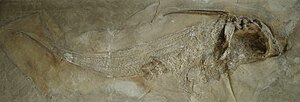Ischyodus
| Ischyodus | ||||||||||||
|---|---|---|---|---|---|---|---|---|---|---|---|---|

Ischyodus quenstedti from the Upper Jurassic of Solnhofen in the Paleontological Museum in Munich |
||||||||||||
| Temporal occurrence | ||||||||||||
| Middle Cenomanian (Upper Cretaceous) to Lutetian ( Eocene ) | ||||||||||||
| 99.6 to 40.0 million years | ||||||||||||
| Locations | ||||||||||||
|
||||||||||||
| Systematics | ||||||||||||
|
||||||||||||
| Scientific name | ||||||||||||
| Ischyodus | ||||||||||||
| Egerton , 1843 |
Ischyodus is an extinct species of sea cat thatoccurredfrom the Upper Cretaceous to the Eocene . Fossils of the genus have been found in North America, Russia, Germany, England, and New Zealand.
features
The representatives of the genus Ischyodus belonged to the large sea cats and were about 1.5 meters long. The head was large and probably had a pointed rostrum . The mouth was slightly below. There were two rows of rhombic teeth in the lower jaw. The palatal teeth were small. The body was long and ended in a pointed tail. The pectoral fins and the first dorsal fin were large. The latter was triangular in shape. It had a large, serrated spine. The males had another, shorter, slightly curved stinger on their heads. The second dorsal fin formed a low fin edge.
Systematics
The genus Ischyodus is placed together with Brachymylus , Pachymylus and Edaphodon in the extinct sea cat family of the Edaphodontidae , which the American ichthyologist Joseph S. Nelson assigns to the plownose chimeras (Callorhinchidae) as the subfamily Edaphodontinae .
literature
- KA Frickhinger: Fossils Atlas Fishes. Mergus-Verlag, Melle 1999, ISBN 3-88244-018-X .
- Joseph S. Nelson : Fishes of the World , John Wiley & Sons, 2006, ISBN 0-471-25031-7 .
Web links
- The Paleobiology Database: Ischyodus Woodward, 1919